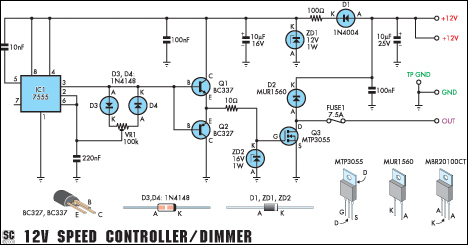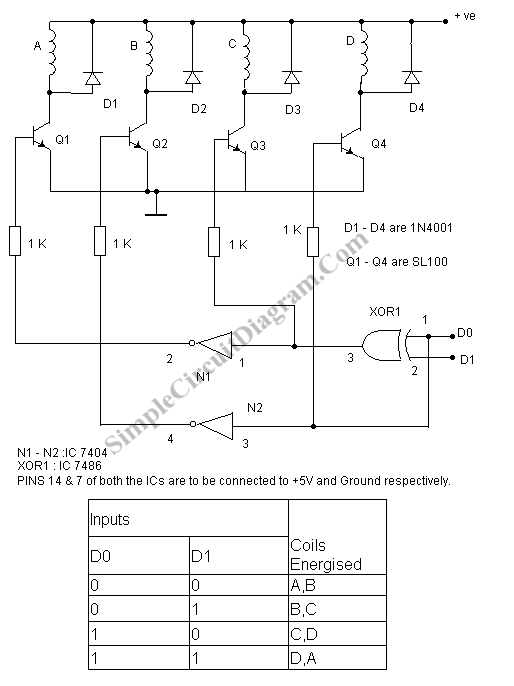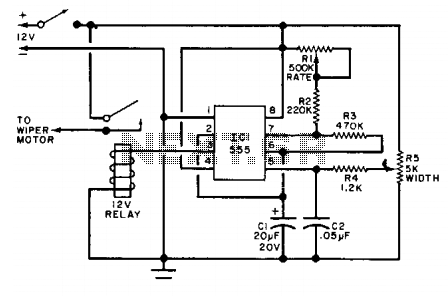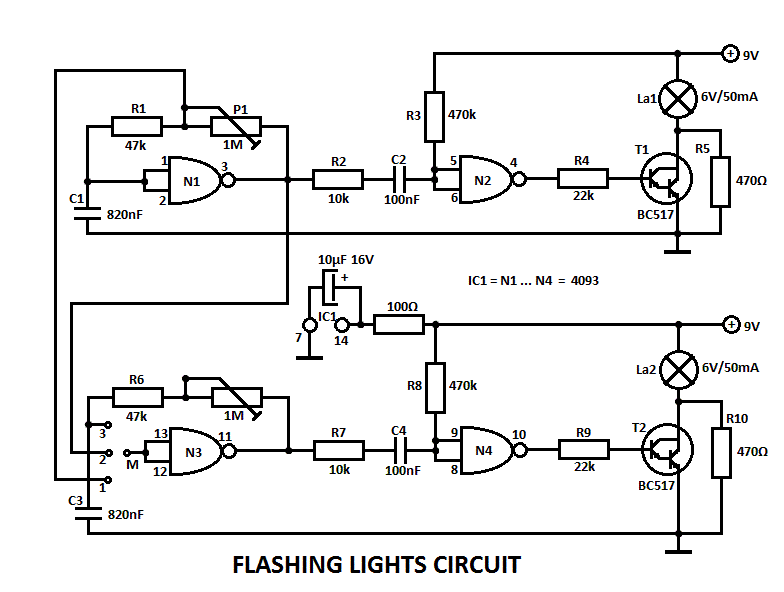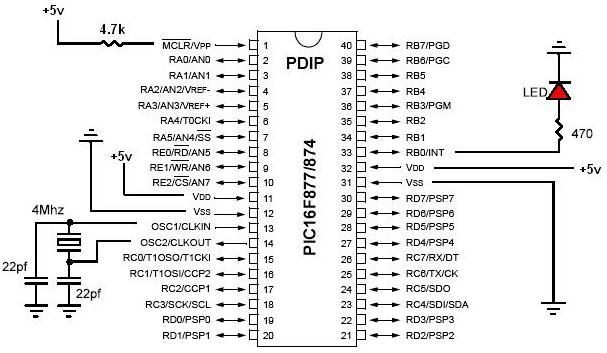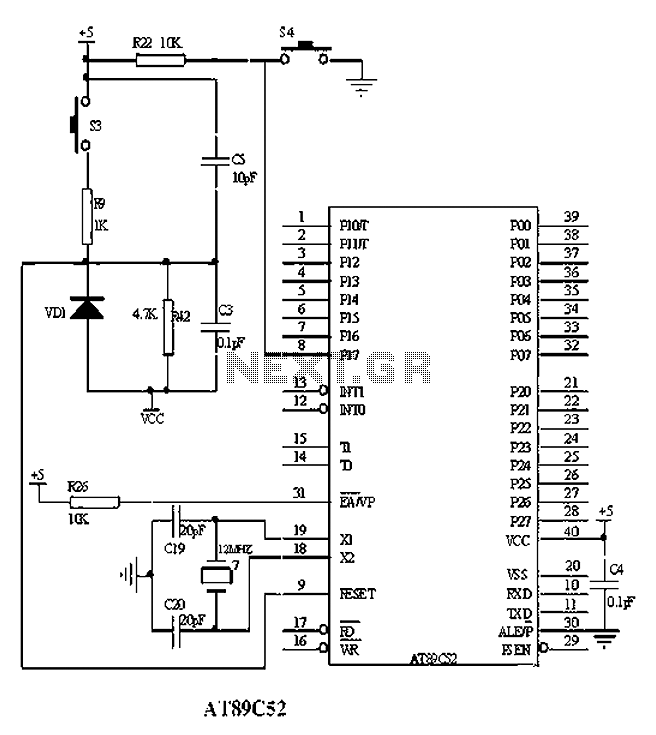
MICROCONTROLLER BASED AUTOMATIC ROOM LIGHT CONTROLLER
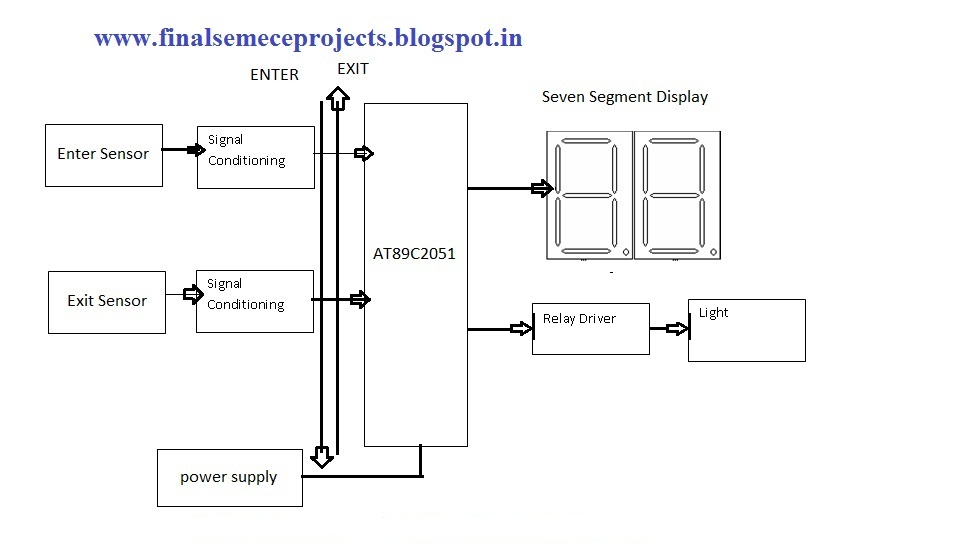
This project involves an automatic room light controller with a bidirectional visitor counter using a microcontroller. It is designed to manage room lighting and accurately count the number of individuals present. When a person enters the room, the counter increments by one, and the lights are activated. Conversely, when someone exits, the counter decrements, and the lights remain on until the last person leaves. The current count of individuals is displayed on seven-segment displays. The microcontroller, specifically the AT89S52, processes signals from infrared sensors, which detect obstructions caused by passing individuals. The project aims to create a model that automates the counting of visitors and controls lighting accordingly. Given the growing demand for automatic appliances, this circuit addresses the complexity of modern living. The basic block diagram includes essential components powered by a +12V and +5V DC supply. The +12V supply powers the relay driver, while the +5V regulated supply is provided by an IC 7805. A light-dependent resistor (LDR) is utilized for person detection. The AT89S52 microcontroller features an 8KB flash programmable and erasable read-only memory (PEROM) and is compatible with the MCS-51 instruction set. It combines a versatile 8-bit CPU with flash memory, making it suitable for various embedded control applications. The circuit employs transistors and relays to control devices, with the output from the AT89S52 driving a relay to manage lighting. Additionally, a 555 timer IC is configured as a monostable multivibrator, functioning as a timing circuit that changes state upon triggering and returns to its original state after a delay.
The automatic room light controller with a bidirectional visitor counter is a sophisticated electronic system that integrates several components to achieve its functionality. The core of the system is the AT89S52 microcontroller, which continuously monitors the input from infrared (IR) sensors positioned at the entrance of the room. These sensors are designed to detect the presence of individuals by measuring interruptions in the IR beam. When an individual crosses the threshold, the IR beam is obstructed, and the microcontroller registers this event, incrementing the visitor count and activating the room lights.
The system's power supply is crucial for its operation. The +12V supply powers the relay driver, which is responsible for controlling the lighting system, while the +5V regulated supply, generated by the IC 7805, powers the microcontroller and other low-power components. The choice of a light-dependent resistor (LDR) in the circuit allows for ambient light sensing, ensuring that the lights are only turned on when necessary, thus enhancing energy efficiency.
The AT89S52 microcontroller's architecture includes 8KB of flash memory, allowing for program updates and modifications without needing to replace the chip. This feature is particularly advantageous for ongoing development and customization of the control algorithms. The microcontroller's output is linked to a transistor that acts as a switch for the relay, which in turn controls the room lighting. This configuration ensures that the system can handle the power requirements of the lighting fixtures while maintaining low control currents.
The inclusion of a 555 timer IC configured as a monostable multivibrator adds an additional layer of functionality to the system. This timer can be used to introduce delays in the lighting control, preventing the lights from turning off immediately after the last individual exits, thus providing a buffer period during which the lights remain on. This feature enhances user experience by ensuring that individuals exiting the room do not find themselves in sudden darkness.
Overall, this project exemplifies the integration of microcontroller technology with sensor systems to create a practical solution for managing room lighting and visitor counting in various applications, from homes to offices. The design emphasizes efficiency, user-friendliness, and adaptability, catering to the increasing demand for automated systems in modern environments.This Project Automatic Room Light Controller with Bidirectional Visitor Counter using Microcontroller is a reliable circuit that takes over the task of controlling the room lights as well us counting number of persons/ visitors in the room very accurately. When somebody enters into the room then the counter is incremented by one and the light i n the room will be switched ON and when any one leaves the room then the counter is decremented by one. The light will be only switched OFF until all the persons in the room go out. The total number of persons inside the room is also displayed on the seven segment displays. The microcontroller does the above job. It receives the signals from the sensors, and this signal is operated under the control of software which is stored in ROM.
Microcontroller AT89S52 continuously monitor the Infrared Receivers, When any object pass through the IR Receiver`s then the IR Rays falling on the receiver are obstructed, this obstruction is sensed by the Microcontroller. The objective of this project is to make a controller based model to count number of persons visiting particular room and accordingly light up the room.
Here we can use sensor and can know present number of persons. In today`s world, there is a continuous need for automatic appliances with the increase in standard of living, there is a sense of urgency for developing circuits that would ease the complexity of life. The basic block diagram of the bidirectional visitor counter with automatic light controller is shown in the above figure.
Mainly this block diagram consists of the following essential blocks. Here we used +12V and +5V dc power supply. The main function of this block is to provide the required amount of voltage to essential circuits. +12 voltages are given. +12V is given to relay driver. To get the +5V dc power supply we have used here IC 7805, which provides the +5V dc regulated power supply. This is one of the main parts of our project automatic room light control. The main intention of this block is to sense the person. For sensing the person and light we are using the light dependent register (LDR). By using this sensor and its related circuit diagram we can count the persons. It is a low-power, high performance CMOS 8-bit microcontroller with 8KB of Flash Programmable and Erasable Read Only Memory (PEROM).
The device is manufactured using Atmel`s high-density nonvolatile memory technology and is compatible with the MCS-51TM instruction set and pin out. The on-chip Flash allows the program memory to be reprogrammed in-system or by a conventional nonvolatile memory programmer.
By combining a versatile 8-bit CPU with Flash on a monolithic hip, the Atmel AT89S52 is a powerful Microcontroller, which provides a highly flexible and cost effective solution so many embedded control applications. This block has the potential to drive the various controlled devices. In this block mainly we are using the transistor and the relays. One relay driver circuit we are using to control the light. Output signal from AT89S52 is given to the base of the transistor, which we are further energizing the particular relay.
Because of this appropriate device is selected and it do its allotted function. This circuit diagram shows how a 555 timer IC is configured to function as a basic monostable multivibrator. A monostable multivibrator is a timing circuit that changes state once triggered, but returns to its original state after a certain time delay.
It got its name from the fact that only one of its output states is stable. It is also known as a `one-shot`. In this circuit, a negative pulse applied at pin 2 triggers an internal flip-flop that turns off pin 7`s discharge transistor, allowing C1 to charge up through R1. At the same time, the flip-flop brings the output (pin 3) level to `high`. When capacitor C1 as charged up to about 2/3 V cc, the flip-flop is triggered once again, thi 🔗 External reference
The automatic room light controller with a bidirectional visitor counter is a sophisticated electronic system that integrates several components to achieve its functionality. The core of the system is the AT89S52 microcontroller, which continuously monitors the input from infrared (IR) sensors positioned at the entrance of the room. These sensors are designed to detect the presence of individuals by measuring interruptions in the IR beam. When an individual crosses the threshold, the IR beam is obstructed, and the microcontroller registers this event, incrementing the visitor count and activating the room lights.
The system's power supply is crucial for its operation. The +12V supply powers the relay driver, which is responsible for controlling the lighting system, while the +5V regulated supply, generated by the IC 7805, powers the microcontroller and other low-power components. The choice of a light-dependent resistor (LDR) in the circuit allows for ambient light sensing, ensuring that the lights are only turned on when necessary, thus enhancing energy efficiency.
The AT89S52 microcontroller's architecture includes 8KB of flash memory, allowing for program updates and modifications without needing to replace the chip. This feature is particularly advantageous for ongoing development and customization of the control algorithms. The microcontroller's output is linked to a transistor that acts as a switch for the relay, which in turn controls the room lighting. This configuration ensures that the system can handle the power requirements of the lighting fixtures while maintaining low control currents.
The inclusion of a 555 timer IC configured as a monostable multivibrator adds an additional layer of functionality to the system. This timer can be used to introduce delays in the lighting control, preventing the lights from turning off immediately after the last individual exits, thus providing a buffer period during which the lights remain on. This feature enhances user experience by ensuring that individuals exiting the room do not find themselves in sudden darkness.
Overall, this project exemplifies the integration of microcontroller technology with sensor systems to create a practical solution for managing room lighting and visitor counting in various applications, from homes to offices. The design emphasizes efficiency, user-friendliness, and adaptability, catering to the increasing demand for automated systems in modern environments.This Project Automatic Room Light Controller with Bidirectional Visitor Counter using Microcontroller is a reliable circuit that takes over the task of controlling the room lights as well us counting number of persons/ visitors in the room very accurately. When somebody enters into the room then the counter is incremented by one and the light i n the room will be switched ON and when any one leaves the room then the counter is decremented by one. The light will be only switched OFF until all the persons in the room go out. The total number of persons inside the room is also displayed on the seven segment displays. The microcontroller does the above job. It receives the signals from the sensors, and this signal is operated under the control of software which is stored in ROM.
Microcontroller AT89S52 continuously monitor the Infrared Receivers, When any object pass through the IR Receiver`s then the IR Rays falling on the receiver are obstructed, this obstruction is sensed by the Microcontroller. The objective of this project is to make a controller based model to count number of persons visiting particular room and accordingly light up the room.
Here we can use sensor and can know present number of persons. In today`s world, there is a continuous need for automatic appliances with the increase in standard of living, there is a sense of urgency for developing circuits that would ease the complexity of life. The basic block diagram of the bidirectional visitor counter with automatic light controller is shown in the above figure.
Mainly this block diagram consists of the following essential blocks. Here we used +12V and +5V dc power supply. The main function of this block is to provide the required amount of voltage to essential circuits. +12 voltages are given. +12V is given to relay driver. To get the +5V dc power supply we have used here IC 7805, which provides the +5V dc regulated power supply. This is one of the main parts of our project automatic room light control. The main intention of this block is to sense the person. For sensing the person and light we are using the light dependent register (LDR). By using this sensor and its related circuit diagram we can count the persons. It is a low-power, high performance CMOS 8-bit microcontroller with 8KB of Flash Programmable and Erasable Read Only Memory (PEROM).
The device is manufactured using Atmel`s high-density nonvolatile memory technology and is compatible with the MCS-51TM instruction set and pin out. The on-chip Flash allows the program memory to be reprogrammed in-system or by a conventional nonvolatile memory programmer.
By combining a versatile 8-bit CPU with Flash on a monolithic hip, the Atmel AT89S52 is a powerful Microcontroller, which provides a highly flexible and cost effective solution so many embedded control applications. This block has the potential to drive the various controlled devices. In this block mainly we are using the transistor and the relays. One relay driver circuit we are using to control the light. Output signal from AT89S52 is given to the base of the transistor, which we are further energizing the particular relay.
Because of this appropriate device is selected and it do its allotted function. This circuit diagram shows how a 555 timer IC is configured to function as a basic monostable multivibrator. A monostable multivibrator is a timing circuit that changes state once triggered, but returns to its original state after a certain time delay.
It got its name from the fact that only one of its output states is stable. It is also known as a `one-shot`. In this circuit, a negative pulse applied at pin 2 triggers an internal flip-flop that turns off pin 7`s discharge transistor, allowing C1 to charge up through R1. At the same time, the flip-flop brings the output (pin 3) level to `high`. When capacitor C1 as charged up to about 2/3 V cc, the flip-flop is triggered once again, thi 🔗 External reference
Warning: include(partials/cookie-banner.php): Failed to open stream: Permission denied in /var/www/html/nextgr/view-circuit.php on line 713
Warning: include(): Failed opening 'partials/cookie-banner.php' for inclusion (include_path='.:/usr/share/php') in /var/www/html/nextgr/view-circuit.php on line 713
